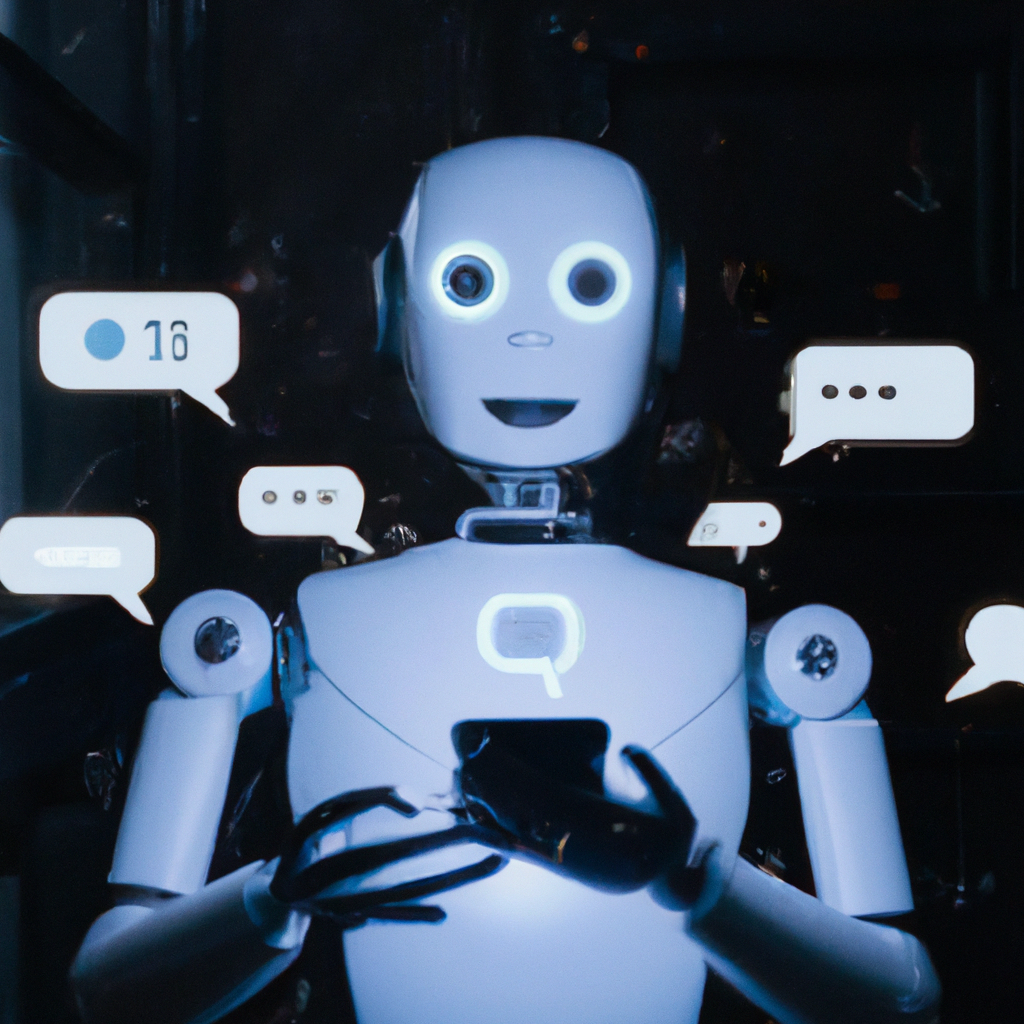Imagine a world where you can effortlessly engage in conversations with artificial intelligence-powered robots. Sounds like something out of a sci-fi movie, right? Well, it’s not fiction anymore. In this article, we will explore the fascinating world of chatbots, those clever virtual assistants that are breathing life into our communication platforms. We will uncover what chatbots are, their incredible capabilities, and how they harness the power of artificial intelligence to provide us with unprecedented levels of convenience and assistance. Get ready to be amazed by the extraordinary potential of these AI marvels.

Defining Chatbots
Definition of chatbots
Chatbots are computer programs designed to simulate conversation with human users. These AI-driven conversational agents use natural language processing (NLP) techniques to understand and respond to user queries. They are typically incorporated into messaging platforms, websites, or mobile applications to automate interactions and provide assistance in various domains.
Purpose and functionality of chatbots
The primary purpose of chatbots is to provide users with personalized and efficient customer service experiences. By leveraging AI technology, chatbots can handle a wide range of tasks, including answering frequently asked questions, guiding users through processes, collecting feedback, and even performing transactions. Chatbots function by parsing and interpreting user input, generating appropriate responses, and learning from each interaction to improve future interactions.
Types of chatbot technologies
There are two main types of chatbot technologies: rule-based chatbots and AI chatbots. Rule-based chatbots follow a predetermined set of rules and patterns to respond to user queries. They are programmed with specific commands and rely on pre-defined responses, making them suitable for simple and predictable interactions. On the other hand, AI chatbots, also known as intelligent chatbots, utilize advanced AI technologies like natural language processing and machine learning to understand and interpret user input. These chatbots can adapt and learn from user interactions, providing more dynamic and human-like conversations.
The Science Behind Chatbots
Understanding Natural Language Processing (NLP)
Natural Language Processing (NLP) is a branch of artificial intelligence that focuses on enabling computers to understand, interpret, and respond to human language. Chatbots rely heavily on NLP techniques to process and extract meaning from user queries. NLP involves tasks such as text tokenization, named entity recognition, language modeling, and sentiment analysis, allowing chatbots to comprehend and generate human-like responses.
Neural network and machine learning in chatbots
Chatbots employ neural networks and machine learning algorithms to enhance their performance. Neural networks, inspired by the human brain, enable chatbots to recognize patterns in data and make predictions based on the underlying patterns. Machine learning algorithms, on the other hand, enable chatbots to learn from user interactions and improve their responses over time. By training on large datasets, chatbots can understand context, infer user intent, and generate more accurate and contextually relevant responses.
Chatbots and their use of language models
Language models, which are integral to chatbot technology, help generate coherent and contextually relevant responses. These models are trained on vast amounts of textual data to understand grammar, syntax, semantics, and context, allowing chatbots to generate conversational and human-like responses. Language models enable AI chatbots to understand the nuances of language, adapt to different user preferences, and provide engaging and interactive conversational experiences.
The History of Chatbots
The conception of chatbots
Chatbots have a rich history that dates back to the mid-20th century. The first chatbot, Eliza, was developed in the 1960s by Joseph Weizenbaum at MIT. Eliza was designed to simulate conversation with a psychotherapist, using pattern matching and script-based responses. Since then, chatbot technology has evolved significantly, driven by advancements in AI, machine learning, and natural language processing.
Notable progress and evolution in chatbot technology
Over the years, chatbot technology has made remarkable progress. In the 1990s, chatbots like A.L.I.C.E. (Artificial Linguistic Internet Computer Entity) introduced more sophisticated natural language processing capabilities. However, these early chatbots were still limited in their ability to understand and generate complex responses. With the advent of deep learning and neural networks, modern chatbots have become more intelligent and capable of engaging in more meaningful conversations.
Current state of chatbot technology
Today, chatbot technology continues to advance rapidly. AI chatbots have become increasingly integrated into various industries, including customer service, healthcare, and e-commerce. The current state of chatbot technology showcases the ability to handle complex queries, learn from user interactions, and provide personalized experiences. As AI and natural language processing techniques continue to evolve, chatbots are set to become even more sophisticated and capable in the future.
How Chatbots Use AI
AI chatbots vs simple rule-based chatbots
AI chatbots differentiate themselves from simple rule-based chatbots by leveraging advanced AI technologies. While rule-based chatbots follow predetermined rules and patterns, AI chatbots utilize machine learning and natural language processing to understand and respond to user input dynamically. AI chatbots can learn and adapt from user interactions, providing more personalized and contextually relevant responses.
Role of AI in understanding and interpreting user input
AI plays a crucial role in enabling chatbots to understand and interpret user input. By leveraging various AI techniques and algorithms, chatbots can process and analyze the text, identify entities and intents, and extract relevant information from the user’s query. AI algorithms enable chatbots to recognize patterns, learn from past interactions, and continuously improve their understanding and interpretation of user input.
AI’s role in dynamic response generation
The use of AI allows chatbots to generate dynamic responses tailored to the user’s specific needs and preferences. AI algorithms enable chatbots to analyze the context of the conversation, consider previous interactions, and generate relevant and contextually appropriate responses. This dynamic response generation capability enhances the conversational experience, making chatbots more engaging, human-like, and effective in assisting users.

Understanding the AI behind Chatbots
Overview of AI technology used in chatbots
Chatbots employ various AI technologies to enhance their functionality. These technologies include natural language processing, machine learning, deep learning, and neural networks. Natural language processing enables chatbots to understand and interpret user input. Machine learning and deep learning algorithms enable chatbots to learn from data and improve their performance over time. Neural networks help chatbots recognize patterns and make predictions based on the underlying data.
Deep learning and chatbots
Deep learning, a subset of machine learning, has revolutionized chatbot technology. Deep learning algorithms are designed to learn and recognize patterns in vast amounts of data. In chatbots, deep learning is used to train neural networks that can understand complex user queries, generate contextually relevant responses, and improve conversational quality. Deep learning enables chatbots to simulate human-like understanding and communication, making interactions more natural and meaningful.
Common AI techniques used in chatbot technology
AI chatbots incorporate several techniques to enhance their performance. These techniques include sentiment analysis, named entity recognition, intention detection, and context-awareness. Sentiment analysis allows chatbots to understand and respond appropriately to the emotions expressed in user input. Named entity recognition helps chatbots identify specific entities mentioned in the conversation. Intention detection enables chatbots to infer user intent and provide relevant responses. Context-awareness allows chatbots to consider previous interactions and maintain a coherent conversation.
Benefits of AI-Enhanced Chatbots
Improvement of customer service
AI-enhanced chatbots offer significant benefits in the realm of customer service. By providing immediate and accurate responses to customer queries, chatbots can enhance customer satisfaction and reduce response times. Chatbots can handle a high volume of inquiries simultaneously, ensuring that customers’ needs are addressed promptly and efficiently. Additionally, AI-enhanced chatbots can learn from customer interactions, improving their ability to provide personalized and relevant recommendations or solutions.
Boosting productivity in businesses
AI chatbots can greatly enhance productivity in businesses by automating repetitive tasks and processes. By handling routine inquiries and providing self-service options, chatbots free up human resources to focus on more complex and value-added activities. Chatbots can handle tasks such as appointment scheduling, order tracking, and product recommendations, reducing the workload on human employees and improving overall efficiency.
Providing personalized customer experience
AI-enhanced chatbots have the ability to provide personalized experiences to customers. By analyzing customer data and preferences, chatbots can tailor their responses and recommendations accordingly. Chatbots can utilize machine learning algorithms to understand user behavior and preferences, enabling them to offer targeted suggestions, promotions, or content. This personalized approach enhances the user experience, increases engagement, and fosters stronger customer relationships.

Examples of AI Chatbots in Use
Usage of AI chatbots in e-commerce
E-commerce platforms have started leveraging AI chatbots to assist customers with their online shopping experience. AI chatbots can answer product-related queries, provide recommendations based on user preferences, and guide customers through the purchasing process. These chatbots can also handle customer inquiries related to order status, returns, and refunds, reducing the need for human intervention and enhancing the overall shopping experience.
Role of AI chatbots in healthcare
AI chatbots are making significant contributions to the healthcare industry. They can act as virtual assistants, providing patients with valuable information about symptoms, preventive measures, and treatment options. AI chatbots in healthcare can help triage patients by assessing symptoms and suggesting appropriate actions. They can also offer mental health support, allowing patients to express their feelings and concerns in a non-judgmental environment.
Use of chatbots in customer service
Customer service departments are increasingly incorporating AI chatbots to handle customer inquiries and provide support. AI chatbots can quickly and accurately respond to frequently asked questions, reducing the workload on customer service representatives. They can also assist in troubleshooting technical issues, collecting customer feedback, and guiding users through self-service options. By handling routine inquiries, chatbots free up human agents to focus on more complex or specialized customer needs.
Limitations and Challenges Faced By Chatbots
Understanding nuances and context in human language
Chatbots face challenges in understanding the nuances and context of human language. Language can be ambiguous, and the same words or phrases can have different meanings depending on the context. Chatbots can struggle when faced with colloquial language, slang, or complex sentence structures. While AI algorithms have improved chatbots’ ability to grasp meaning, there are still limitations in fully understanding context, humor, or sarcasm.
Limited knowledge base and learning barriers
Chatbots rely on the information and data they have been trained on. If the chatbot’s knowledge base is limited or outdated, it may struggle to provide accurate or relevant responses. Additionally, chatbots may face learning barriers if they lack access to real-time data or if they encounter new information or concepts that they have not been trained on. Balancing the need for a broad knowledge base and the ability to learn in real-time poses a challenge for chatbot developers.
Dealing with complex queries and unusual contexts
While chatbots have improved in handling a wide variety of user queries, they can still struggle with complex or unusual contexts. These queries may involve multiple intents, require deep domain knowledge, or demand a high level of reasoning and comprehension. Chatbots may encounter difficulties in generating accurate responses or may resort to providing generic replies. Handling complex queries and unusual contexts remains an ongoing challenge for chatbot developers.

Working Through the Limitations of Chatbots
On-going research and development
To address the limitations of chatbots, extensive research and development efforts are underway. Researchers are continuously exploring ways to improve NLP techniques, enhance context understanding, and overcome language comprehension challenges. Advances in AI, machine learning, and deep learning algorithms are paving the way for more sophisticated and capable chatbots that can handle complex queries and understand context more accurately.
Advancements in AI and machine learning
Advancements in AI and machine learning are instrumental in enhancing chatbot capabilities. Continued improvements in neural networks, deep learning architectures, and training algorithms enable chatbots to learn from larger and more diverse datasets. These advancements empower chatbots to understand language nuances, cope with more complex queries, and generate better responses. As AI and machine learning technologies evolve, chatbots are expected to become smarter and more efficient.
Evolving NLP techniques
The field of natural language processing is continuously evolving, leading to the development of more advanced and effective techniques. NLP researchers are exploring methods to improve sentiment analysis, contextual understanding, and language modeling. By incorporating cutting-edge NLP techniques into chatbots, developers can mitigate limitations related to language comprehension, understanding context, and generating more nuanced and contextually appropriate responses.
Future of Chatbots and AI
Predictions for chatbot technologies
The future of chatbot technologies is promising, with several advancements expected to revolutionize the field. Chatbots will continue to become more intelligent, understanding and responding to user queries with greater accuracy. They will leverage AI advancements like deep learning and natural language processing to provide more human-like conversational experiences. In the future, chatbots could also integrate other emerging technologies, such as computer vision, to enhance their capabilities and broaden their applications.
Influence of AI innovations on chatbot development
AI innovations will significantly influence the development of chatbots. As AI algorithms become more sophisticated and capable, chatbots will be able to understand human language, emotions, and intent more accurately. AI innovations will also enhance chatbot learning abilities, enabling them to adapt to new information, improve responses through reinforcement learning, and demonstrate higher levels of reasoning and comprehension.
Potential impacts on industry and customer service
The widespread adoption of chatbot technologies, coupled with advancements in AI, will have a significant impact on various industries and customer service practices. Chatbots will streamline and automate customer service processes, reducing costs and improving efficiency. They will enhance the customer experience by providing personalized and contextually relevant interactions. Additionally, chatbots will enable businesses to gather valuable customer insights and improve their products and services based on user feedback, leading to increased customer satisfaction and loyalty.
In conclusion, chatbots are AI-driven conversational agents that have the ability to simulate conversation with human users. They utilize natural language processing, machine learning, and deep learning techniques to understand and respond to user queries. Chatbots have come a long way since their inception, evolving from simple rule-based systems to intelligent agents capable of providing personalized and efficient customer service. Although they face challenges in understanding nuances, expanding their knowledge base, and handling complex queries, ongoing research and development efforts, along with advancements in AI and NLP, are shaping the future of chatbot technologies. With the potential to revolutionize industries and transform customer service practices, chatbots are poised to become an integral part of our everyday lives.











